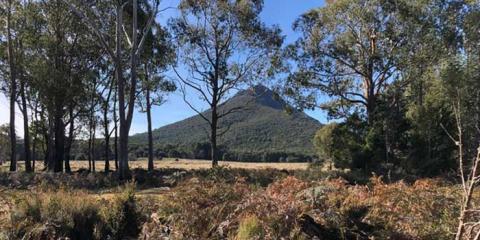Traveling to Tasmania
December 10, 2019
I’m in a forest filled with eucalyptus trees, standing next to ferns taller than I am. I’m definitely feeling like I’m not in Kansas anymore! Or, to be biologically correct, I’m not in my native Douglas-fir forest type. Instead, I’m far from home in a forest on Mount Wellington in Tasmania, overwhelmed by all the plants and animals I’m seeing that I’ve only ever read about in textbooks.
I’m here representing the OFRI as a guest of the Forest Education Foundation Inc. (FEF). FEF is nonprofit educational institution that has been providing learning experiences for teachers and students throughout Tasmania for over 25 years. It’s a bit like OFRI in that it receives its core funding by way of sponsorship from Sustainable Timber Tasmania and the Forest Industries Association of Tasmania. And, just like OFRI, education is a priority for the foundation.
Last year two educators from FEF, Darcy Vickers and Hannah Kench, visited Oregon to find out about K-12 forestry education resources and programs offered here. They toured the state and visited the sites of various forest education field programs, including OFRI’s Natural Resources Education Program at The Oregon Garden as well as Forest Today and Forever’s Forest Field Days program in Lane County and the Oregon Department of Forestry’s program at the Tillamook Forest Center.
They were also very interested in OFRI’s Oregon Forest Literacy Plan (OFLP), a conceptual framework for educators that lists concepts about our forests every K-12 student should know. Their goal was to write a plan for Tasmanian forests following our model.
This year Darcy and Hannah invited me – plus Rick Zenn, a senior fellow at the World Forestry Center in Portland, and Joan Mason Ruud, state director of Talk About Trees, a classroom program for preschool through eighth-grade students that’s funded largely by OFRI – to visit Tasmania and present sessions on K-12 forestry education at their “The Stories Behind the Trees” conference, held Oct. 31 and Nov. 1.The conference was attended by classroom teachers and representatives from their forest sector.
On the first day of the conference, the Forest Education Foundation rolled out their forest literacy plan, which is modeled after OFRI’s Oregon Forest Literacy Plan. Conference attendees discussed the plan and why it’s important to both foresters and educators.
The second day of the conference was a forest tour that featured their new Forest Field Day program. It’s modeled after the Forest Today and Forever program Darcy and Hannah observed in Lane County last year. It featured a series of learning stations in the forest where students learn about various forest-related topics, including soil, wildlife and wood products. Instead of measuring Douglas-fir trees at the forest inventory station, we measured eucalyptus trees! The pilot program was well received by conference attendees.
It was inspiring and gratifying to see how well these “Oregon ideas” for K-12 forest education worked in Tasmania. I’m looking forward to more communication and sharing of ideas with the Tasmanian educators.
Norie Dimeo-Ediger
Director of K-12 Education Programs
